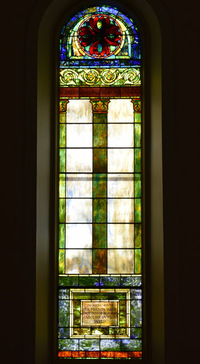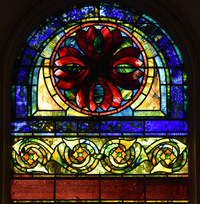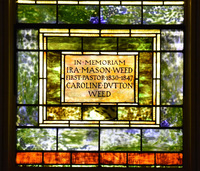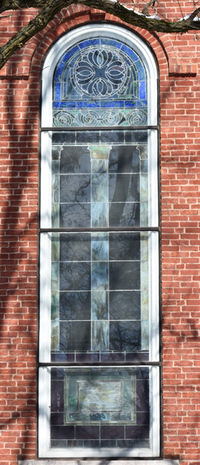Window
Building Name: First Presbyterian ChurchStudio Name: Tiffany Studios
City: Ypsilanti
Window Shape: 3 (arched)
Date of Window: 1899
Subject/Title of Window: Weed Memorial
Brief Description of Subject: The middle section in this memorial window was designed to let light through. Doric columns are pictured as if holding up the canopy and divide this middle section into two lights. These columns are in harmony with the façade which is in the Grecian Doric style.
From the booklet, "Our Memorial Windows: A Brief Description of the Memorial Windows in the Sanctuary of The First Presbyterian Church, Ypsilanti, Michigan," by Doris Milliman, City Historian, page 23-25.
The Weed Window
Ira Mason Wead*
January 14, 1804 - November 30, 1871
Caroline Dutton Wead
February 17, 1809 - July 3, 1887
On the first Sunday in July 1830, in the little Red School House at the corner of Washington and Congress (now Michigan Avenue) Streest, the Reverend Ira Mason Wead preached his first sermon in Ypsilanti to a congregation of 35 people who had organized themselves as a church in the previous year. Mr. Wead noted that, "When I came to Ypsilanti, the leading men, with but few exceptions, were infidels. Infidelity was bold and rampant; intempereance, Sabbath breaking, and profanity were pervalent; the moral influences of the place were few and feeble. A few prominent men, from the first, gave their attendance upon the means of grace, and aided in the support of the Gospel; but a larger portion were in open and decided opposition, and seemed determined that the Gospel should not be planted there." When he died in Ypsilanti, forty one years later, our community was a growing, prosperous, respectable city, with strong churches, proclaiming the Gospel. Ira Wead had done much to bring about that transformation.
Hinesburg, Vermont was the place of his birth. He graduated from the University of Vermont, and entered the law offices of a Judge Fine in Ogdensburg. Although he showed promise of a successful career as a lawyer, he "became impressed with religious truth," as one of his contemporaries said, and decided to enter the ministry. He entered Andover Theological Seminary in Boston and three years later in 1829, he was graduated and ordained to the gospel ministry. In May 1830, he married Caroline Dutton, received a commission and financial support to do missionary work in Ypsilanti from the Board of Home Missions, and made the long journey with his bride from Vermont to Ypsilanti, arriving here sometime in June.
The first years were not easy for the twenty-six year old preacher and his twenty-one year old wife. There was opposition to the Gospel and its moral duties. The support from the Board of Home Missions and from the small congregation was just barely adequate. There were all the hardships and discomforts of the frontier. Nevertheless, Mr. Wead was a talented man, ful of missionary zeal. Withing two years the congregation was organized as a Presbyterian Church, three elders were elected, and Session minutes have been kept regularly since that time. In 1834, the first church building was completed, the congregation assumed full support of their minister, and Ira Wead was installed as first pastor of the Presbyterian Church. On a typical Sunday, he would come to Church early in the morning, light a fire with wood which he had brought on the previous day, preach the morning service, conduct the Sunday School which followed, preach at the noon service, lead the afternoon prayer service, and then preach at the evening service. The Church experienced steady growth throughout his pastorate.
Mr. Wead resigned in 1847, and went to Chicago, where he became an agent for the American Board of Foreign Missions, promoting the cause of worldwide missions throughout the Midwest. About 1856, he became a financial agent for the educational institute at Lake Forest, Illinois. In 1866, he and his wife and daughter, Sarah Caroline, returned to Ypsilanti, where he spent his retirement in active service in this Church and neighboring churches. In 1857, he had returned from Chicago to participate in the dedication of our present Sanctuary. Sunday, November 19, 1871, he worshiped in this place for the last time, and on November 30, after an illness of ten days, he repeated the last words of the Bible, "Come, Lord Jesus," and he was gone.
Ira and Caroline Wead were the parents of five children, but three of them, Mary Ann, Theodore Mason, and Henry Dutton, died in infancy. Harriet Elvira lived from August 22, 1850 to May 28, 1880. Sarah Caroline was baptized in 1834. She returned to Ypsilanti with her parents in 1866, and along with her mother became active in the Women's Foreign Missionary Society. She was one of the early presidents of that Society. She died in 1925.
Ira Wead and his wife and children are buried in Highland Cemetery (Block 28, Lot 20). A Tiffany window in the cemetery chapel is dedicated to him.
The Ira Mason Wead and Caroline Dutton Wead Window reminds us of the early difficult days of our Church, and of its ledership which was fully and firmly dedicated to the Lord Jesus Christ. We have received through Ira Wead's pastoral service not only a Church, but a living faith, which isnpired us to continue to advance the Kingdom which he served so faithfully all the years of his life.
As the Reverend G. P. Tindall, the pastor of our Church at the time of his death, said, "Being dead, he will not cease to speak to us all."
*In the first Session Book and in his letters to the Mission Board, our first pastor always signed his name: IRA M. WEAD. We do not know why his name on the window is spelled WEED.
Inscriptions: In Memoriam
Ira Mason Weed
First Pastor 1830-1847
Caroline Dutton Weed
Condition of Window: Very good
Height: 15'8"
Width: 4'2"
Type of Glass and Technique: Opalescent Glass, Lead Came
Weed Memorial
Weed Memorial top
Weed Memorial inscription
Weed Memorial outside
The MSGC is a constantly evolving database. Not all the data that has been collected by volunteers has been sorted and entered. Not every building has been completely documented.
All images in the Index are either born-digital photographs of windows or buildings or are scans of slides, prints, or other published sources. These images have been provided by volunteers and the quality of the material varies widely.
If you have any questions, additions or corrections, or think you can provide better images and are willing to share them, please contact donald20@msu.edu






